Where I found Whitman
I posted my Whitman reading a few days ago to the map portion but didn’t include it on my blog.
This reading was done in Whitman park in Brooklyn.
I posted my Whitman reading a few days ago to the map portion but didn’t include it on my blog.
This reading was done in Whitman park in Brooklyn.
Fort Greene
History is all around us, especially in Whitman’s Brooklyn. I am aware that New York City has many historical landmarks but I didn’t realize the significance of Fort Greene and how Whitman helped create it.
The class met at the park, along the way I saw Walt Whitman projects across the street. We met in the spot below near the small building:
We where greeted by people from the Whitman Project.
The CUNY Walt Whitman class had the pleasure and privilege to be guided by artistic director Greg Trupiano. He gave us some background
We first spoke about Leaves of Grass. The artistic director (Greg Trupiano) pointed out some physical qualities of the first book and an image of Whitman. Most people in the 19th century, especially writers like Emerson dressed in a very professional manner. Whitman instead is dressed in a working man’s clothes. He looks like a regular blue collar worker in his book of poems. This is more significant then I thought and one of the reasons that Whitman is seen as the people’s poet.

Blue Collar Whitman
Mr. Black who is another person affiliated with the Whitman project read a poem from Whitman’s Collection. I didn’t get a chance to record his passionate reading but I think one of my classmates capture it with a flipcam.
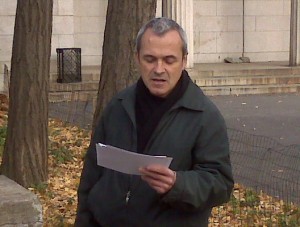
The next discussion was about setting type. The image below is a keep sake that Greg Trupiano gave the class from his own private collection.
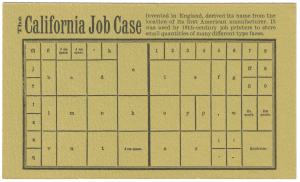
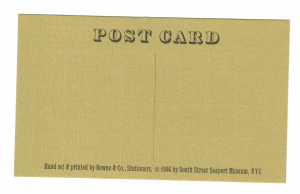
We then dicussed the reasons why Whitman pushed for the creation of Fort Greene. To summarize:
1. He felt the Wallabout Martyrs deserved a proper monument.
2. He used his influence as the editor of the Daily Eagle to persuade people to support his cause.
3. He lived in the area and thought that people should have a park to enjoy.
Fun Anecdote # 1
I learned about how the terms uppercase and lowercase came about. Uppercase or capital characters are higher and harder to reach then lowercase when people use to set type; makes sense.
Fun Anecdote #2
“Having a copyright doesn’t mean you wrote the book.”
Fun Anecdote #3
Leaves of Grass was banned in Boston in the early 1880s which added to the book’s controversy. Subsequently, the 1880 copy was the best selling edition of Leaves of Grass.
We made our way torward The Tombs which you can see in the video below.
The Tomb is really an incredible piece of history. Some of the old bones from the old memorial wihch just fell apart over time.
Best picture I took in my life… ever
Our tour concluded with a walk around the Brooklyn neighborhood and a look at 99 Ryerson street. It’s the last piece of history in New York that Whitman lived in that is still standing today. Students from Pratt currently inhabit the building.
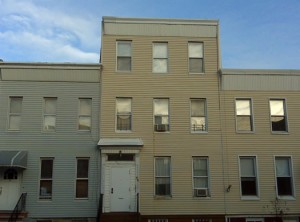
Resources: These are additional links to learn more about Walt Whitman and the park
[1] This is the website of Greg Trupiano about Whitman http://www.whitmanproject.org/
[2]Wikipedia is a decent place to start when looking for leads and additional information regarding a topic. It is by no means authoritative. http://en.wikipedia.org/wiki/Fort_Greene
[3] Fort Greene Park Conservancy http://www.fortgreenepark.org/pages/contents.htm
[4] This website provides a historic context of the park: http://www.historicfortgreene.org/
Franklin Evans Part II
After reading my first post on Franklin Evans, I think I alluded to some important details. Franklins Evans was a novel written by Walt Whitman before he released his celebrated poems, Leaves of Grass. A Google search of Franklin Evans yields almost no content related to Whitman while Song of Myself is a Whitman trademark. Professor Gold stated that most people still don’t know that Walt Whitman wrote Franklin Evans. Whitman even denied writing Franklin Evans at one point but this was proven false. That is one of the reasons the novel is over looked.
Franklin Evans is a novel about intemperance or alcoholism as we call it today. Intemperance has always been a problem in society and it’s vividly described by Whitman as one of the worst evils man can commit. Through the narration of the protagonist Franklin Evans, Whitman shows us the dark side of drinking. The progression of Alcoholism starts destroying Franklin’s life and affecting his loved ones. Evans loses jobs, destroys his marriages and goes to jail as a result of his brandy escapades.
From the offset of the novel, Franklin is always observing the affects of alcohol on people’s lives. His first description of drunkeness was speaking of a farmer who had gone astray due to drinking. Franklin Evans was not drinking at this point, and then he met Colby and that was soon to change. When Colby asks Franklin to join him for a drink, he obliges and goes along with it. He regrets this action and thing come full circle at the end of the story.
I can trace the outset of all frailties, as well all the calamities that have befallen me in life, to that fatal night when Colby drew me into the drinking place; where, amid music and gayety, the first step in my downward road was taken.
Franklin makes drinking seem as an almost inescapable force to that drags down young men in Cities. Many in the novel have fallen prey. This novel is an attempt to encapsulate the many misfortunes a man can meet when he drinks. Franklin Evans stroke of luck saves him, only to sucumb to drinking again. In the conclusion, Whitman calls this novel an experiment. It is not only a look at drinking but a short treatise on temptation in the 19th century. Many temperance groups appeared during the 19th century that discouraged drinking and other vices. This novel is arguably influential and is one of the first pieces of fictional literature that could have been called the Washingtonian Manifesto.
The following quick blogpost is to provide some tips on our location projects. I decided to go to the Brooklyn Historical Society today and start my search on my location (120 Prince Street). The first step I recommend is by starting with your designated year of your location and find it in Atlas Map. It will guide your investigation throughout the day.
For every Atlas map you look at, get the following information:
1. Year plus Volume – It’s important you label your data and notes as things can get confusing very quickly.
2. Your block number
3. The page you found your location
4. The area which can be found in the first couple pages of your Atlas map. Think of it as the Index.
5. Get the cross streets and intersections NEAR your location. This will help your search and when you move to other time periods, you are able to correlate location data.
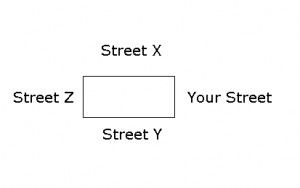
6. Count how many houses from the corners is your location
7. Note the color of the structure which will identify the material
8. How many floors does your structure have?
This is not everything list but this should give you some ideas. I highly recommend drawing a picture or taking a set of photos. My location is weird, my streets were renamed and my block was divided by another street. I am thankful that a Elizabeth helped me put the pieces together.
After you have found your location on all the maps, you should move to the Land Conveyances.
Find out your block number start searching. You may have to refer back to your map data to make some sense of the land conveyances. You should be looking for key information like:
1. A particular buyer or sell that shows up a lot
2. Changes on the structure of your block and the day they occurred.
3. Any Whitman names in the Grantor/Grantee lists. One of our classmates found Whitman’s father which gave him an additional lead.
4. Any landmarks or important buildings
The building numbers may change but you should be using your main location from the Atlas map and try to find the physical location, the number is secondary.There isn’t one way to do this kind of research. Different locations will yield different results but I have to be fairly thorough and methodical in the ways I look for information. As I continue to do my own research, I will post some tips for my classmates. If anyone has any questions, just comment so I can clarify on my post. That way, everyone can benefit. Refer to the “How to do House and Building Research at BHS” handout. I think the key thing is to collect as much relevant data and search through all the different resources available to continue finding leads and piece everything together.

The following post is some reflection regarding the novel Franklin Evans written by Walt Whitman. Many people till this day don’t even know that he wrote this novel. I quizzed some people in the Apple store and to no one knew…
Franklin Evans is
Franklin Evans is certainly a different novel It has an underlying message and it’s delivered in dramatic fashion. We all know the evils of alcoholism today but it can be viewed as even more destructive in the nineteeth century. The epsisodes that Evans are caused due to his love affair with Brandy and the like. After reading the introduction, I had an idea of what the book is about; intemperance. Professor Gold graced us with a primer to intemperance and reminded us of different movements to abolish alcohol. With this sort of historical context in mind, I proceeded to read the novel.
Whitman presents intemperance from a Washingtonian perspective. Each chapter has a dramatic episode where those who drink are possessed and become demons. In the beginning of the novel, there are descriptions of intemperate folks. He judges characters by their eyes and levels of redness in their faces. In speaking about a person,Evans (our main character use to know)
“The truth is, that habits of drunkeness in the head of the family, are like an evil influence- a great dark cloud, overhanging all, and spreading its gloom around every department of the business of that family, and poisoning their peace etc.”
He clearly dissaproved of drinking saw situations that intemperance lead to the destruction of families, especially in the father. Every character he meets is under examination of consumption of alcohol. He looks for redness in the face and bleary eyes, the byproduct of a few too many drinks many nights.
Despite some resistance from the offset, Colby drags the inexperience Evans to the bar. Evans problems with alcohol began after ” We took our station at the first vacant seats, and called for our drinks. How delicious everything seemed!!”
The next morning. Evans woke up remorseful. He regretted those drinks he had but he’d inevitably would drink again. Evans gets a nice paying job and loses it because of his intemperance. He was to deliver a package for Mr. Lee and failed to so, intemperance now costs him his job. In each episode, the price he pays for his intemperance escalate. He loses a wife to his intemperance later in the story and in another drunken rage is arrested for attempted theft. In the novel, Evans starts to blame Colby for introducing him to the thrills of alcohol. Evans made his own decision and didn’t have the fortitude to limit his consumption of the deadly drink. You’d think he would turn around at this point but I will leave that discuss for the next blog post.
On a related note, I stumbled upon a website dedicated to moderation management. Most approaches to vices are pure abstinence but this website takes a realistic approach. You can have a drink or two and not be an alcoholic.
New York City College of Technology Whitman class made a field trip to the Brooklyn Historical Society on November 3, 2009. We met in front of the Brooklyn Historical Society with Professor Gold where we greeted by Elizabeth Call. She is the Special Collections Librarian and has immense knowledge of resources available at the Museum. Some of these resources are:
I will see if I can get a digital copy of the handout discussing these sources.
Thanks to the generosity of the NEH Office for Digital Humanities, we have a semester pass to the museum and library. We can find sources from Brooklyn we can’t find anywhere else. This blog post is a highlight of some of the things we saw.
Upon entering, I wondered why the class made a trip here. Professor Gold told us we would be using this resource for our next project. We are going to become experts of a particular historical Whitman location. We will be looking for pieces of history around the city, especially Brooklyn using the aforementioned resources.
This library was literally old school. It had card catalogs and microfiche repositories; I haven’t seen one of those in years.
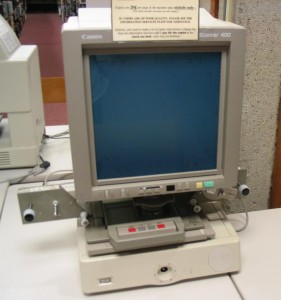
From Wikimedia
We took a look at the Atlas maps from different time periods. I didn’t know that such precise records were kept of Brooklyn in the 19th Century. The class saw Atlas maps from the 1820s up to the 1920s. Brooklyn has changed substantially. This will make our historical location project more difficult. In some cases, some streets may not exist in the past.
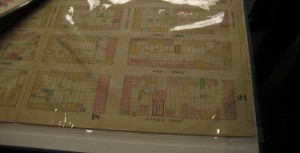
In the diagram above, you can see small boxes that are pink and yellow. Yellow stands for wood while pink stands for stone. The building numbers and block numbers are even on the map along with another slew of details.
The library has the Brooklyn City Directories that are something like our phonebooks today. These were published periodically in the past. This link is an example of the physical resource. You can look for someone’s name and find out where he or she lives and their profession. I could link the name to an address and then pull up a map to see where they lived. With their name, I can do research on them and do some follow up work. Elizabeth even found Walt Whitman’s father but not his son.
The Library even has the Brooklyn Daily Eagle from 1841-1950s. I can be sure I can find many of Whitman’s journalism articles in that collection in their original form.
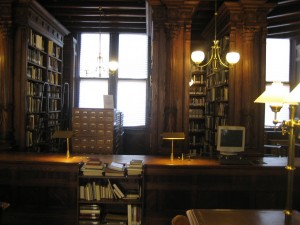
Because this library has so many resources, many people visit it to prove that an area or a building is a landmark. Elizabeth Call (our guide) gave us a helpful tip when it comes to researching our sites. She said, “check if the address is in a landmarked neighborhood”. If it is, you can find a wealth of information due to its landmark status and significance. Anyone can get a historical perspective of Brooklyn through the library’s historical documents.
The library was particularly cold, old books don’t like moisture and the air conditioner was on full blast the duration of the trip. From the Atlas maps to the articles, and scrapbooks down to the deeds, we can uncover pieces of history and bring them together.
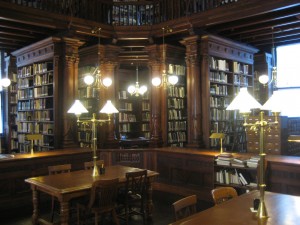
The library is open Wednesday to Friday from 1-5 PM. My classmates will be sure to visit this incredible resource that I didn’t know existed in our search for Whitman.
While I was surfing the web on a rainy night, I stumbled a documentary called USNOW. The reason I felt this documentary was relevant to the Looking for Whitman Project was because it embodies one of the main themes of the project, community participation. USNOW is a documentary that discusses how user participation and group collaboration tools allows individual people to come together to accomplish incredible things. Three online communities are highlighted:
1. Couch Surfers – share hospitality with one another
2. Zopa – a marketplace where people lend and borrow money to and from each other, sidestepping the banks
3. Ebbsfleet– a user and community owned soccer club
More information is available in their respective websites.
While not directly related to Whitman literature, the first thirty minutes of this short documentary discusses the implications of new media and web2.0 technologies. These technologies have allowed for the creation of a digital community that is being actively used for this digital experiment (Looking For Whitman). This project is creating a community of knowledge regarding a very influential writer in American history.
Each class is taking a different look at Whitman’s word depending on their geographical location and time period in his life. At the end of the semester, the project will have hundreds of pages analyzing the poet. Any casual student of Whitman’s work can browse through these pages to learn about Whitman from several angles. Each college can present a different perspective due to our locations and we tie everything together through the website.
As stated in the documentary, the web drops collaboration costs so low now that consumers can create and produce meaningful bodies of work. When the internet was first coming alive, it was intended for research academics to share information but it has become a commercial vehicle for companies around the world. The Looking for Whitman project is taking the original purpose of the Internet back to its roots.
The existence of this project on the web creates transparency. New pieces of work are released often. Everyone is able to use and scrutinize this piece of work. I can leave comments on my classmate’s pages with questions, which lead to more investigation. People help each other through the comments and allow us to expand our knowledge. Everything is done in plain sight so everyone else can benefit.
The online environment is decentralized with little moderation. If this kind of project scales to the thousands, a small community of moderators would rise to ensure the quality of the posts. How can we trust the integrity of the work, some will way. I cannot claim with certainty that everything in this project is 100% accurate but that goes for any content online.
No longer do people have to work in ivory towers to publish meaningful works. The costs of producing and distribution content such as pod casts, writing, and movies are essentially zero. The only major investment these days is time and having access to the internet.
We are in the infancy of group collaboration tools. New technologies such as Google Wave will help shape the group collaboration landscape. Technology is changing the way we do things everyday. One such example is telecommuting which allows works to work from home remotely. As long as I have access to the internet, I can get work done anywhere, regardless of the location.I recommend that anyone give this short documentary a look if they wish to have a different perspective on how new media collaboration can and is shaping our future.
You can download the film using a torrent client from their website.
On another note, something peculiar happened in class recently. Three students let the professor know they were going to be late but used different channels of communication. One student tweeted, another used facebook and the last sent a traditional email. These are definitely a sign of the times. There are so many channels of communication available these days that if you need to reach someone and give them some information, you will probably be able to. The next challenge is communicating with someone but selecting the appropriate channel.
Views of New York: two different authors
Walt Whitman lived in New York for a part of his life. In Whitman’s readings, you notice he is the immense love he has for the scenery and the American people.
His view of Manhattan is the following:
A million people—manners free and superb—open voices—hospitality—the most courageous and friendly young men; The free city! no slaves! no owners of slaves! The beautiful city, the city of hurried and sparkling waters! the city of spires and masts! Whitman
Charles Dickens visit to they United States and especially New York was heavily anticipated. After his journal entry of describing the tombs and five point slums, Americans had mixed feelings and felt betrayed by the prolific author. He starts off by comparing New York to Boston but only notes the negative things:
The Beautiful Metropolis of America is by no means so clean a city as Boston, but many of its streets have the same characteristics; except that the houses are not quite so fresh colored, the sign-boards are not quite so gaudy, the gilded letters not quite so golden, the bricks not quite so red, the stone not quite so white, the blinds and area railings not quite so green, the knobs and plates upon the street doors not quite so green, and the plates upon the streets doors not quite so bright and twinkling.
It’s as if New York at a first glance looks unpolished and seems to be fading away in comparison to Boston and other Cities in America. Looking at the jail that is affectionately known as the tombs, Dickens portrays the dark side of America. New York doesn’t seem like the City of the free. Even if someone has committed a crime, they are still entitled to their basic rights. A child is treated no differently and is subjected to these terrible conditions in this prison, a pit of misery where many have committed suicide, hence the name “The Tombs”.
Into this narrow, grave-like place men are brought to die. The wretched creature stands beneath the gibbet on the ground, the rope about his neck’; and when the sign is given a weight at its other end comes running down, and swings him up into the air – a corpse.
This grim depiction of an inmate’s death must have surprised readers. Many readers would be looking for a positive look of things in New York. Charles Dickens audience would be people in England. All we see are all the flaws, which we know exist but are described so feverishly.
Blogging is more revolutionary then people think. It’s one of the more popular activities on the web and if you’re not writing one, then you are certainly reading them. Blogging is a new platform for self-expression on the web. Websites such as Blogger and WordPress take all the technical difficulties out of the equation allowing people to focus more on primarily one thing; Content.
A blog is:
(a contraction of the term “weblog“)[1] is a type of website, usually maintained by an individual with regular entries of commentary, descriptions of events, or other material such as graphics or video.
We can derive from the definition above that Blogging (verb) is the act of posting and maintaining a blog. Web 2.0 is a paradigm shift in the way the Internet is used and viewed. In web 1.0, most of the websites were static and only offered information. Forums were used to discuss such content. Web 2.0 is all about user contributed content and collaboration thought the web. Blogs have really led the way and are the purest incarnation of web 2.0
Having students post on blogs has several implications. Because blogs were made for sharing and public in nature, students are motivated to produce quality work. They know that anyone can bring up their page and read their writing. In a traditional classroom, you can just hand in poor work and not care too much because only your professor will read and grade it. With a larger audience such as the web, students are hesitant to post work without thought. It can also scare students into not doing any work because they are afraid of having their worked scrutinized. If a student lacks confidence in their writing, they become paralyzed as a result.
Another aspect to consider is the permanency of the Internet. Once something is online, it’s there forever. Almost everything on the web is crawled by web engines and archived for research and other use. One example of this process is the waybackmachine website which makes complete copies of certain websites. People can jump online and look at older versions of certain websites. Things like the ‘waybackmachine’ may increase the anxiety of students who know their work is out there forever. I feel blogging is suited for more advance courses.
The immediacy of information at our fingertips makes the internet a great resource. Students will look for their answers on the Internet regardless so why not bring it into the classroom. I notice students have difficulty separating their online habits. Personally, when I chat with friends, I am using abbreviations and other jargon because I want to get my point across and I have another five blinking windows open. Students have to be careful and not allow their casual online presence to spill when they write academically. Hopefully, students can stay away from Facebook and other websites and get their work up.
Students are becoming part of the blogopshere, a community of contributors about various topics of the world. Students may not want to be in the public eye for various reasons. Employers are known to search for your name and should some questionable content come up as a result of that search, you may not get a job. A person’s online presence is very important and people don’t understand how to manage it. I tell people to assume their is no privacy on the Internet. Anything you post is open to questions by various parties, even if you toggle the privacy button.
I follow many blogs myself and find them to be valuable resource of information. Blogging is the new way companies provide their customers with updates (I didn’t forget about Twitter but I will get to that one day). Students are learning how to contribute to the online community, thank goodness there is an edit button while they do it. Students get to state their opinions and become independent thinkers. When they leave class, they may start a blog of their own on a particular topic they have a passion for. More importantly, they are become independent publishers of their own work… like Whitman.